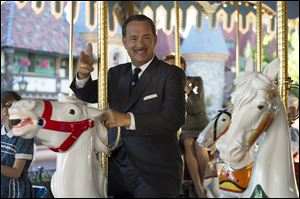
MOVIE REVIEWS
‘Saving Mr. Banks’ dishes the dirt and the heartbreak behind ‘Mary Poppins’
12/20/2013It’s a Hollywood legend that Walt Disney felt some sort of malevolent glee in killing Bambi’s mom, and what that animated death would do to the children who saw it. But that’s only a legend.
P.L. Travers, the woman who wrote the glorious Mary Poppins, was a brittle, snobbish martinet and a humorless control freak. And that’s a fact. Stay through the credits of Saving Mr. Banks and hear for yourself.
Emma Thompson brings Travers to prickly life in Saving Mr. Banks, Disney’s amusingly testy and emotionally rich telling of Walt Disney’s courtly struggles with the dismissive writer as he and his dream factory turned her Mary Poppins into one of the most beloved children’s musicals ever.

Tom Hanks as Walt Disney in a scene from "Saving Mr. Banks."
The courtship — Tom Hanks plays patient, long-suffering Disney — is not an easy one. She is in the habit of barging into the movie / TV / theme park mogul’s office. He is all charm and informality. He calls her “Pam.”
We meet Travers in London, her agent telling her she needs the money and must finally sell the screen rights to her most famous book.
Travers flies to Los Angeles and disapproves — of everything. The flight, the scent in the air, the hotel.
“Let’s make something wonderful,” Walt purrs.
“I won’t have her turned into one of your silly cartoons!”
Director John Lee Hancock (The Blind Side) keeps this courtship center stage, and tells the story of Walt figuring out why Travers (real name, Helen Lyndon Goff) is the way she is and what he can do to make this unpleasant and miserable woman happy. That discovery is in the film’s many flashbacks, to young Helen Goff’s childhood in rural Australia, where her overwhelmed, worried mother (Ruth Wilson) was dependent on Helen’s father (Colin Farrell, very good), a drinking banker who would rather play with his kids than show up for work.
The flashbacks give the story its pathos. The battles in the early ’60s in Burbank, Calif., deliver the laughs, and lots of them. Travers came to “supervise” the planned film, basically threatening to back out of the deal over the casting of Dick Van Dyke, over the inclusion of an animated sequence, over the silly, made-up-word songs of the beloved Disney house composers, the Sherman Brothers (Jason Schwartzman and B.J. Novack, a hoot), and other irritants.
Directed by John Lee Hancock.
Written by Kelly Marcel and Sue Smith.
A Walt Disney Studios release, playing at Cinemark Franklin Park, Fallen Timbers, and Levis Commons.
MPAA rating: PG-13 for thematic elements including some unsettling images.
Running time: 125 minutes.
Critic’s rating: ****½
Cast: Emma Thompson, Tom Hanks, Colin Farrell, Paul Giamatti, Rachel Griffiths, Jason Schwartzman.
Hanks wears Walt’s moustache and comfortingly plays Walt’s Midwestern drawl (and smoker’s cough). And this always-reliable leading man ably suggests the gentle but firm never-take-no-for-an-answer movie mogul as he lays on the folksy charm to a woman who is, in every way, immune to it.
“I could just eat you up!” he says, and she recoils. “You have got to share ‘her’ with me,” he pleads.
Travers will not have this story — forged in a dark childhood that desperately needed a magical nanny to rescue her and her family — “careening towards a [Disney] happy ending, like a kamikaze.”
Thompson plays Travers as a fairy godmother who has given up the sweet act to show her Cruella De Vil side. She is hilariously unpleasant, downright rude. But we, like Walt and her Disney-provided driver (Paul Giamatti), can sense that it’s all an act, and that this pose has deep-rooted, painful underpinnings. It’s a great performance and an exclamation point on Thompson’s career.
The film’s a trifle long, especially for a story whose ending, we know, was a happy one. But with Saving Mr. Banks, Hancock, Thompson, and Hanks find that holiday film sweet spot, blending the poignant with the unpleasant, the grim with the giddy.
It was never going to be “Supercalifragilisticexpialidocious.” Reserve that honor for the film that inspired it. But Saving Mr. Banks is still one of the best pictures of the year.